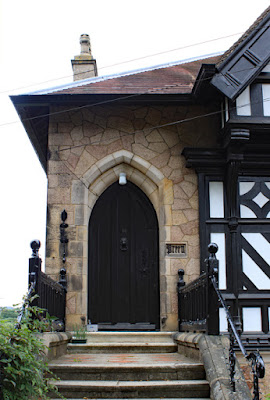 |
| The former Carterknowle Council School |
Continuing my planned walk from Woodseats to Heeley, I had by now encountered the Woodseats Council School, various interesting C20 buildings in and around Abbey Lane, Commonwealth War Graves in Abbey Lane Cemetery and some geology at the old Marriott Wood Brickpit.
I had already walked 5 km and with it now being 3 o’clock in the afternoon, I decided that my original idea to visit three more Sheffield Board Schools was too ambitious and, having photographed the Park Lodge former police station for the British Listed Buildings website, I made my way along Abbeydale Road towards the former Carterknowle Council School.
Stopping briefly to look at the stone in the boundary walls on the west side of Abbeydale Road, which looks like the Greenmoor Rock, I soon arrived at the junction with Bannerdale Road, where the imposing Church of St. Peter and St. Oswald forms a notable local landmark.
I just took a few general photographs of the elevations that I could see and, on this occasion, I didn’t get near enough to the church to examine its stonework but, looking at a distance, my impression was that the stone wasn’t quarried in Sheffield.
Even though quite dirty, I saw no obvious various in colours and textures between the massive rock faced walling and the sawn dressings and these could quite easily be the same stone. Completed in 1914, the railway network of the time would have enabled the best quality medium grained gritstone to be easily brought from Derbyshire or West Yorkshire.
Making my way up Bannerdale Road to Carterknowle Council School, built in 1906 to a design by Holmes and Watson, I was very surprised to see a very attractive Arts and Crafts style, compared to the bleak design by H.L. Paterson at Woodseats Council School earlier in my walk – a characteristic of most of the early C20 Sheffield Board Schools that I had seen to date.
The rooflines of this Grade II Listed building are punctuated with interesting architectural features, such as Flemish gables, octagonal towers with ventilation louvres, and bell turrets – all of which are reminiscent of the details that were commonplace before C.J Innocent was dismissed as a contracted architect in 1881 and the Sheffield School Board became more mindful of the costs of the schools that they were commissioning.
Looking at the fabric of the building from beyond the boundary walls, the severe blackening of the stone makes it difficult to identify the rock faced wall stone with any certainty, but the lack of iron staining and obvious colour variation in the stone used for the school and the caretaker’s house suggests that it is the usual Crawshaw Sandstone.
As with the vast majority of the Sheffield Board Schools that I had seen to date, the inscribed coarse grained sandstone gate piers at the various entrance for boys and girls have fine examples of raised letter carving - this time in the Arts and Crafts style.
Having taken a series of general photographs of the school, I made my way down Carterknowle Road and was interested to see a Classical style building that is constructed in a yellow coloured sandstone, which forms the side of a snicket that runs towards Abbeydale Road.
Going down the snicket and carrying on to Abbeydale Road and then to Barmouth Road, I realised that this might in fact be related to Abbeydale House, dated c.1848, which was built for John Rodgers of the renowned cutlery company, Joseph Rodgers and Sons.
Although the principal building is finished with painted stucco, when investigating its outbuildings, I discovered that these were built in the same sandstone as the building that I had just seen. Its very distinctive uniformly yellow colour is very similar to the buildings in Grenoside and at Hillsborough Barracks, where Grenoside Sandstone has been extensively used.

























































